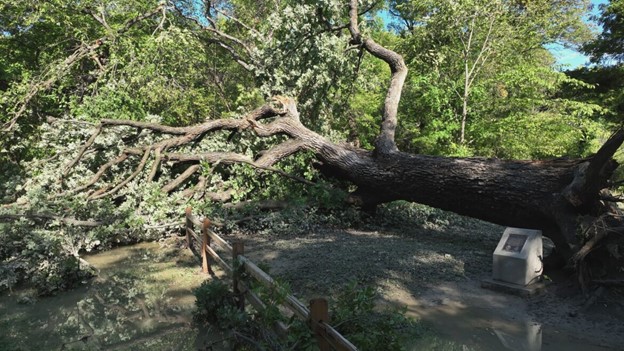Local artists turn a more than 400-year-old tree into art pieces

Published June 28, 2024, By ALYSSA HIGH
Local artists turn a more than 400-year-old tree into art pieces

Plano’s Quadricentennial Bur Oak. Photography courtesy of Plano Parks & Rec
If a tree falls in the woods and no one hears it, does it still make a sound? I’m not sure about the science on that, but Plano’s Quadricentennial Bur Oak, located in Bob Woodruff Park and believed to be more than 400 years old, fell after the stormy weather last October. Whether or not it made a sound, parks employees and Planoites felt its loss.
Plano Parks and Recreation posted about the loss of the tree on October 27, 2023. According to the department, the tree’s scientific name is Quercus macrocarpa, and it stood 90 feet high and had a circumference of 15 1/2 feet. As arborists believe the tree to be more than 400 years old, many felt the weight of the historic events the tree has lived through. Older than dirt doesn’t quite cut it.
The tree likely predated the first English settlers arriving at Plymouth Rock. The signing of the Declaration of Independence. Sliced bread. Five out of the six flags over Texas. Yeah, you read that right. When this tree was just a sapling, Plano was a contested area between Indigenous tribes, the Spaniards and the French.
“We’ve been maintaining this tree for probably 25 years or more, so it’s kind of like an old friend to me,” Steve Houser, owner of Arborilogical Services says in a video from the City of Plano. “This is the oldest tree in North Texas. It’s not just any tree. If the tree could talk and tell you stories at that age, it saw Indians gathering underneath it and traveling throughout the area.”
Plano Parks & Recreation officials announced the falling of the tree on Facebook with a warning to avoid the area due to unsafe conditions and a “farewell old friend” to the altitudinous arbor.

Plano’s Quadricentennial Bur Oak in 1979. Photography courtesy of Plano Parks & Rec.
“We got a large amount of rain in a short period of time and with the preexisting conditions of the tree having the crack that we worked on a few years ago and some of the rot that was in the tree, that amount of rain forced the tree to fall down,” says Marc Beaudoing, a Plano urban forester.
Despite reduction pruning, fertilizer injections and insecticide injections, the tree has been leaning more and more over the last 10-20 years, Beaudoing says.
“It’s not like any other tree that I’ve been in. When you climb out on the ends and you’re out there and the wind is kind of rocking you back and forth, it’s like this ancient old lady is kind of rocking you back and forth in her hands and in her arms and it’s very relaxing, very rewarding,” Houser says. “You start to sense the personality of the trees when you’ve spent a lot of time climbing them, moving throughout their limbs and things of that nature, so it’s my absolute favorite tree of all time. It’s a tremendous loss for the field of arboriculture, for anybody that really cares and loves these old trees. From a historical perspective, it’s a tremendous loss.”
The video brought dozens of community members together to talk about memories they’ve had under the tree. Former Boy Scouts who trekked the area. Moms who picnicked or went on walks in the area with their now-grown children.
“As a middle schooler at Armstrong Middle school, our coaches and teachers would take us for a campout there called “Gathering at the Gray Oak.” We would walk from Armstrong and sleep under the stars at night. It was beautiful and magical and the best of times. We learned so much about one another,” Planoite and Facebook user Cheryl True Kool commented on the video.
While many Planoites called for various uses of the tree’s wood, parks and recreation representatives say most of the tree is rotted and unusable for lumber. The unusable parts will be recycled, while smaller branches and foliage will be processed and spread around the area where the old tree once stood to benefit the soil and encourage young things to grow.
“Notwithstanding the large amount of rot, we still hope to repurpose some of the healthy wood into commemorative wood pieces,” a parks and recreation representative says. “For safety purposes, the area will be fenced off until the area is safe. We ask the public to stay clear of the area until this initial work has been completed.”
The tree was later cut into 5-foot sections ranging from four to 50 inches in diameter. North Texas artists and woodworkers applied online in March for a chance to take one of the pieces and turn it into artwork. Those selected will be able to sell, donate and/or keep the finished product.
“We would like to thank our community partners for assisting us in putting this call for artists together and look forward to repurposing this tree’s legacy into beautiful works of art with the help of local artisans and woodworkers,” says urban forester Marc Beaudoing.
While which artists have been accepted to use the wood from the tree have not yet been publicly announced, we can all look forward to seeing how our neighbors commemorate the historic hardwood.
https://planomagazine.com/local-artists-turn-a-more-than-400-year-old-tree-into-art-pieces/
